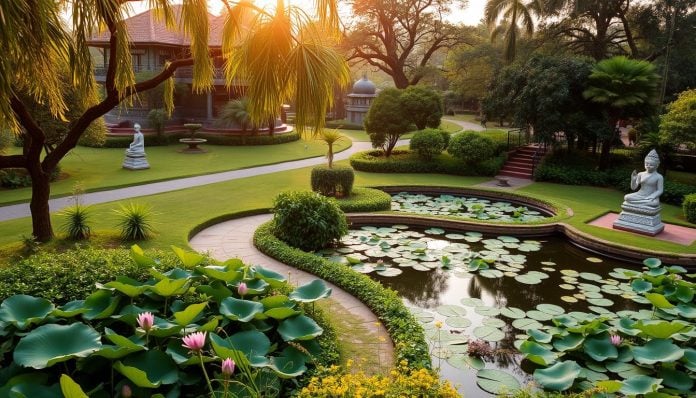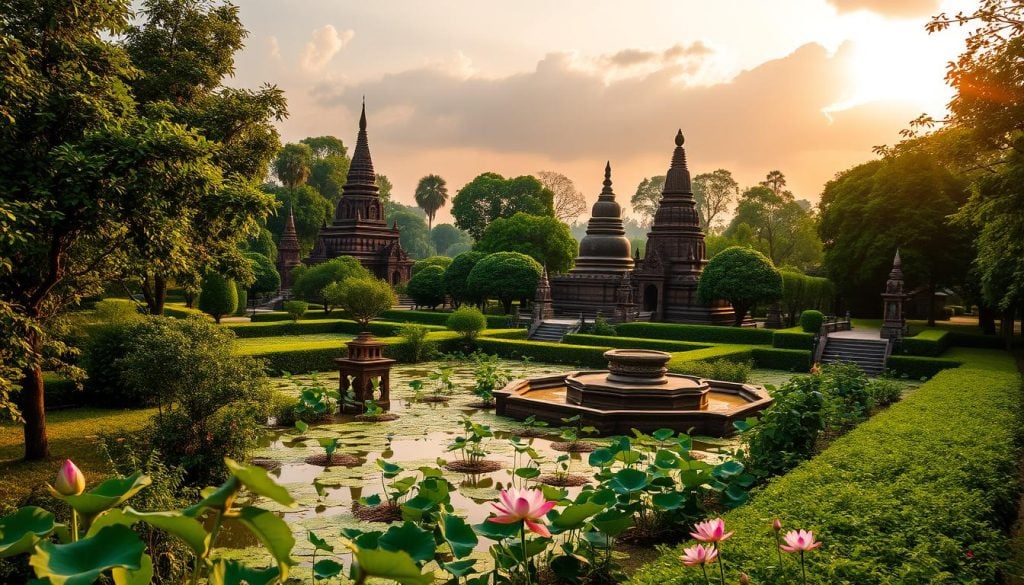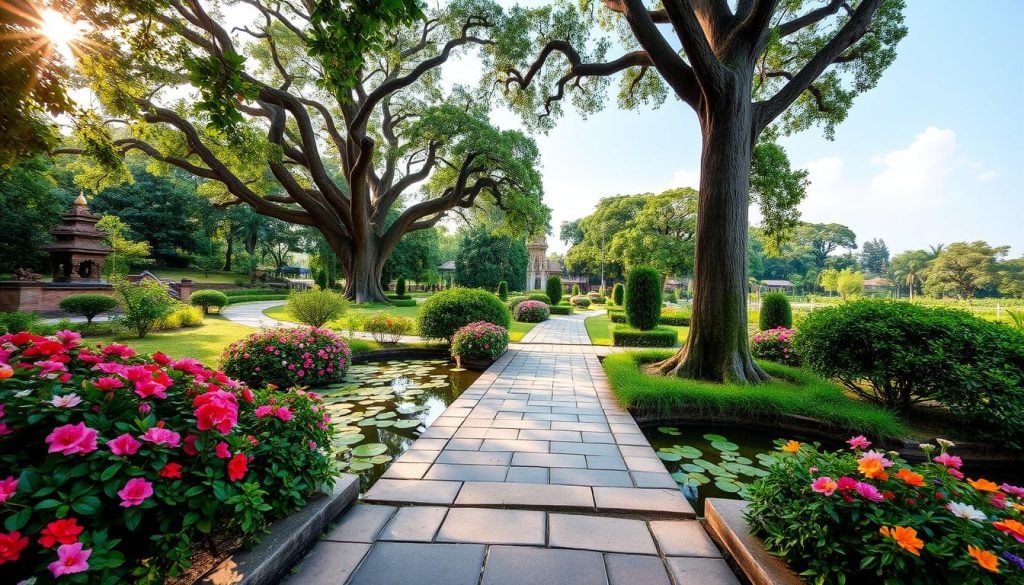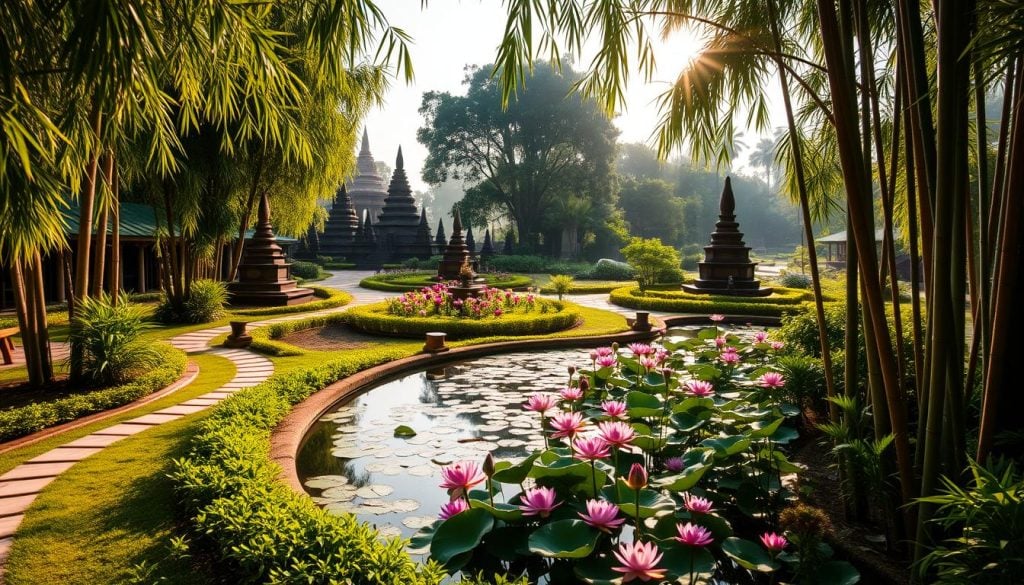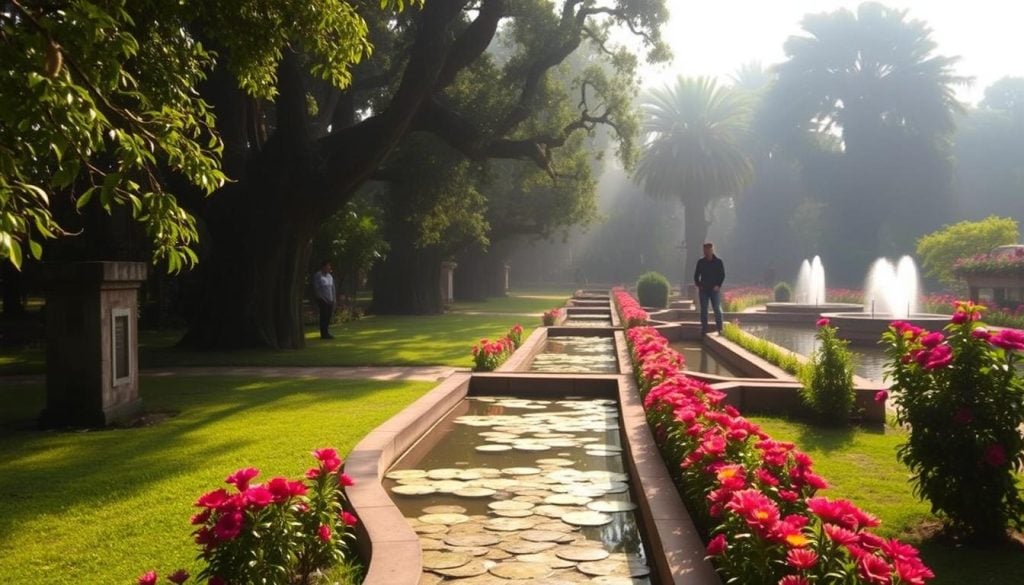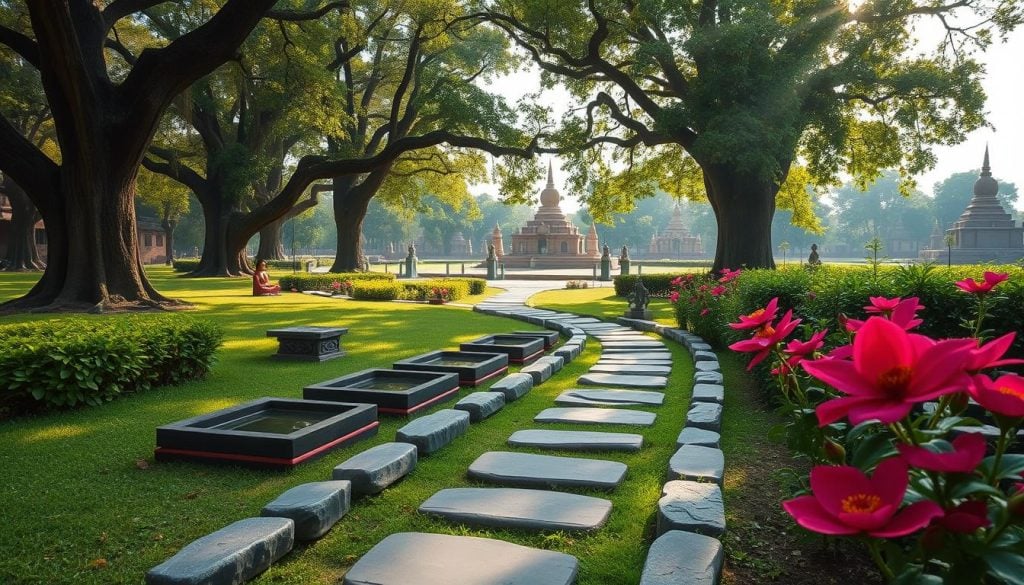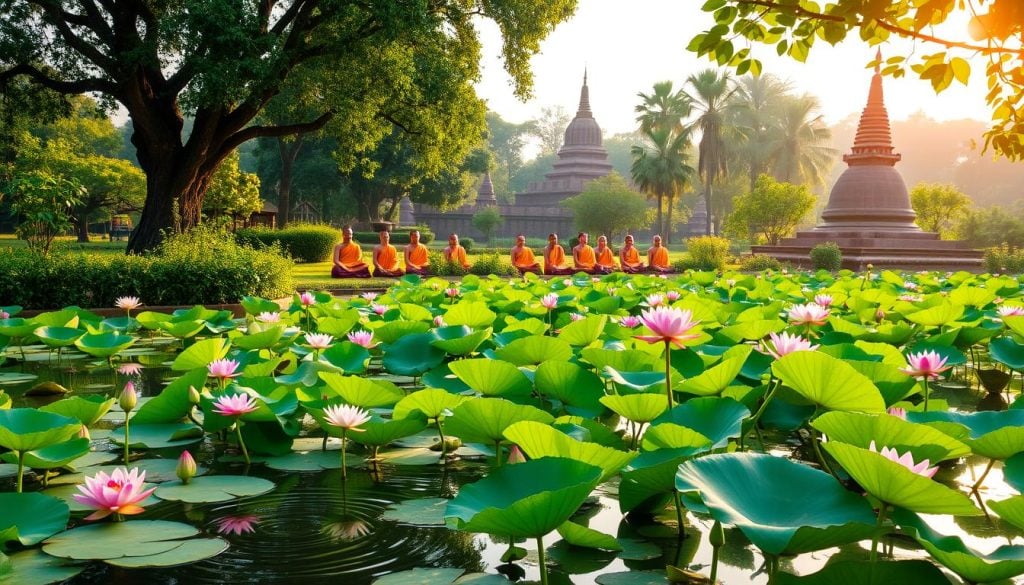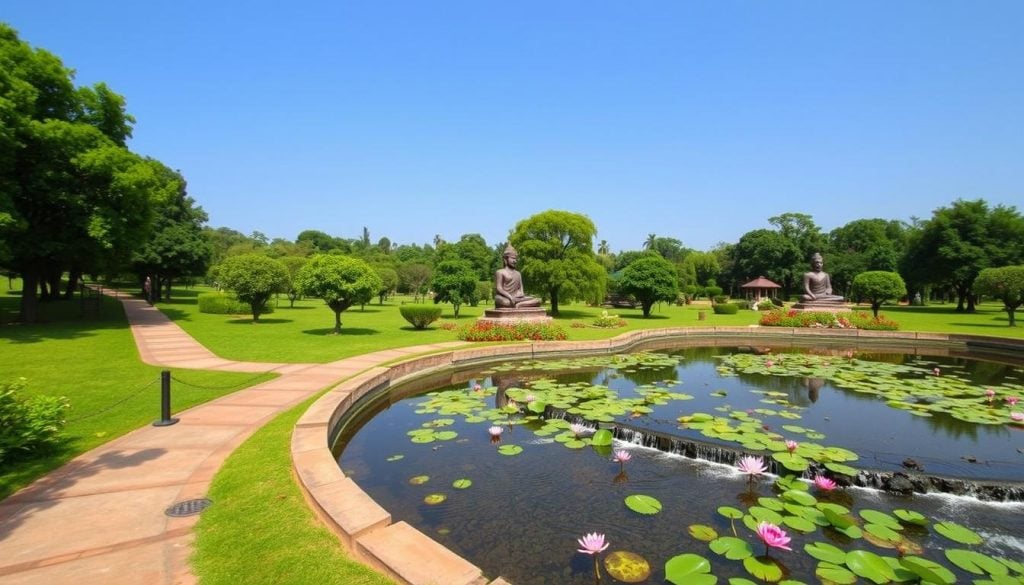Have you ever wondered what it feels like to mediate amidst the serene landscapes of a World Heritage Site?
Welcome to Lumbini, the birthplace of Siddhartha Gautama. Here, the meditation gardens are peaceful sanctuaries for all. They are not just beautiful; they hold the essence of peace. Lumbini is known worldwide for its natural beauty and spiritual connection.
Visit these meditation gardens in Lumbini. Here, you can reflect on yourself and feel the calm that surrounds this special place.
The Significance of Lumbini as a Sacred Site
Lumbini is a holy site in Buddhism, known worldwide as Buddha’s birthplace around 563 BCE. It’s not just about buildings; it’s a mix of culture, spirituality, and history. Buddha himself named it one of the four pilgrimage spots, drawing visitors from all walks of life.
Visiting Lumbini is more than a religious trip. You’ll find Lumbini peaceful sanctuaries perfect for quiet reflection and enlightenment. The gardens and temples are calm spots for meditation, making Lumbini a top choice for those seeking peace.
Lumbini’s importance goes beyond its past. Walking through its paths and buildings, you’ll feel a deep calm. It’s a place for personal growth and reflection.
| Features | Significance |
|---|---|
| Birthplace of Buddha | Origin of Buddhist teachings |
| Sacred Garden | Ideal for meditation and reflection |
| World Heritage Site | Cultural and historical preservation |
| Monastic Complex | Diverse architectural styles representing various cultures |
A Journey Through the Lumbini Master Plan
The Lumbini Master Plan is a carefully designed vision. It focuses on Buddhist symbolism and peaceful geometric layouts. Architect Kenzo Tange created it in 1978. It covers about 4.8 kilometers by 1.6 kilometers, with zones that show the heart of Buddhist teachings.
Walking through this site, you’ll see nature and monastic buildings together. This mix creates a calm atmosphere for meditation gardens in Lumbini. Your journey starts in New Lumbini Village and ends at the Sacred Garden. Along the way, you’ll see how Buddhist thoughts have grown.
Every part of the plan is meant to be peaceful. It highlights Lumbini meditation spots for deep thinking and reflection. It helps visitors understand their spiritual journey better.
The plan focuses on peace and spirituality. It connects Buddhist philosophy elements, offering a deep look into Lumbini’s sacredness. Exploring this landscape is a special chance to connect with meditation’s essence.
| Zone | Description |
|---|---|
| New Lumbini Village | A modern gateway that welcomes pilgrims and visitors to explore Lumbini’s heritage. |
| Sacred Garden | A central area that encompasses the sacred Bodhi tree and various meditation spots. |
| Monastic Zones | A variety of monuments and structures representing different cultures and architectural styles. |
| Natural Areas | Beautiful landscapes designed to enhance meditation practices and spiritual reflection. |
Meditation Gardens in Lumbini: A Tranquil Escape
The meditation gardens in Lumbini are a sacred place for peace and thought. At the heart is the Sacred Garden, a mix of greenery and history. It’s a spot where you can feel close to Buddha’s teachings, surrounded by ancient shrines and grand monuments.
Overview of the Sacred Garden
The Sacred Garden is the core of Lumbini’s meditative spaces. It has wide lawns and paths with many spots for meditation. Walking through, you feel the peace and enlightenment, surrounded by nature’s beauty.
Peaceful Natural Areas for Meditation
Outside the Sacred Garden, there are more peaceful spots for quiet reflection. These areas are perfect for personal spiritual journeys. Sitting under a tree or by a stream, you’ll find the sounds of nature enhance your meditation.
Diverse Monastic Zones and Their Inspirational Architecture
The monastic zones of Lumbini show a stunning mix of spiritual buildings from all over the world. Each monastery, built by different countries, brings its own cultural touch and style. This makes Lumbini not just a spot for spiritual growth but also a global art gallery. These areas are perfect for both worship and quiet reflection.
Exploration of Different Cultural Styles
Walking through the monastic zones, you’ll see amazing architectural variety. The Chinese Monastery’s designs reflect traditional Chinese art. The Thai Monastery’s bright colors show Thai Buddhist influences. The Tibetan Monastery adds its own charm with a mix of local and Tibetan styles.
This mix of cultures makes your visit special. You get to see the teachings of Buddha in beautiful art.
The Role of Various Countries in Shaping Lumbini
Every country has added to Lumbini’s architecture and spiritual feel. This teamwork shows the world’s love for meditation and peace. People come to these peaceful gardens to learn about Buddhism.
These buildings help us understand Buddhism’s many practices. They guide us on a spiritual journey.
The Maya Devi Temple: Heart of Lumbini
The Maya Devi Temple is a key spot in Lumbini, marking where Buddha was born. It attracts many pilgrims wanting to learn more about Buddhism. The temple complex has ancient ruins and the Ashokan Pillar, showing great respect for Buddha.
When you get there, you feel a calm atmosphere. It’s one of the best places for meditation in Lumbini. People meditate here, enjoying the peace. The temple is a place for spiritual thinking, showing Lumbini’s peaceful nature.
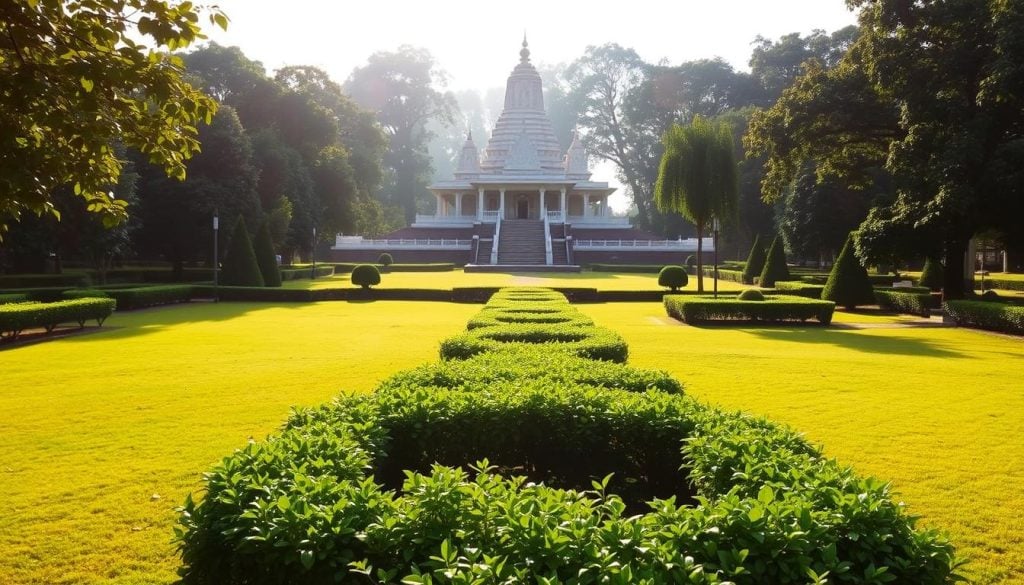
In the temple’s heart, many rituals and ceremonies happen all year. These events bring people together and offer a deep look into Buddhism. They help visitors understand the importance of this place for meditation.
| Aspect | Details |
|---|---|
| Location | Lumbini, Nepal |
| Historical Significance | Buddha’s birthplace |
| Key Features | Ancient ruins, Ashokan Pillar |
| Spiritual Activities | Meditation, rituals, ceremonies |
| Visitor Experience | Peaceful reflection and spiritual growth |
Visiting the Maya Devi Temple deepens your understanding of Lumbini’s spiritual side. It’s a key spot for those looking to connect more with meditation and mindfulness.
Understanding the Historical Context of Lumbini
Lumbini’s history is key to its status as a major pilgrimage site. Exploring the area, you’ll find archaeological sites that shed light on Buddha’s life. These sites also show the cultural richness of the region.
They offer deep insights that make visiting the meditation gardens in Lumbini even more meaningful. You’ll connect with the area’s sacred spaces on a deeper level.
Exploring Archaeological Sites Around Lumbini
The archaeological sites near Lumbini give us a peek into ancient times. They show how the area has changed over centuries.
- The ruins of ancient monasteries reveal the architectural styles of their time.
- Artifacts discovered in the region showcase the cultural practices of early Buddhists.
- Excavations highlight the lifestyle and spiritual quests of the people who inhabited the area.
The Influence of Buddha’s Life on the Area
Buddha spent his early years in Kapilavastu, near Lumbini. This connection makes Lumbini a special place for spiritual seekers. The landscape here reflects Buddha’s teachings, inviting you to find peace in the meditation gardens.
Exploring Lumbini’s history adds depth to your visit. It shows how history, culture, and spirituality blend here. This unique blend makes Lumbini a special destination for meditation.
Other Notable Lumbini Meditation Spots
Lumbini has many peaceful places for meditation. Each spot offers a unique experience for those looking for calm and reflection. Two sites are especially notable for their beauty and the peace they inspire.
World Peace Pagoda: Symbol of Serenity
The World Peace Pagoda is a stunning sight in Lumbini. It’s designed to show the world’s wish for peace. Here, you can join others in meditation, surrounded by beautiful gardens.
Visiting this place can be a deep experience. It makes you think about your own path to peace and the world’s.
Eternal Peace Flame: Reflection and Significance
The Eternal Peace Flame is another key spot in Lumbini. It stands for the ongoing search for peace. It’s a quiet place for visitors to think and connect with Lumbini’s ideals.
The flame is more than just a symbol. It reminds us of peace’s power to help us grow spiritually.
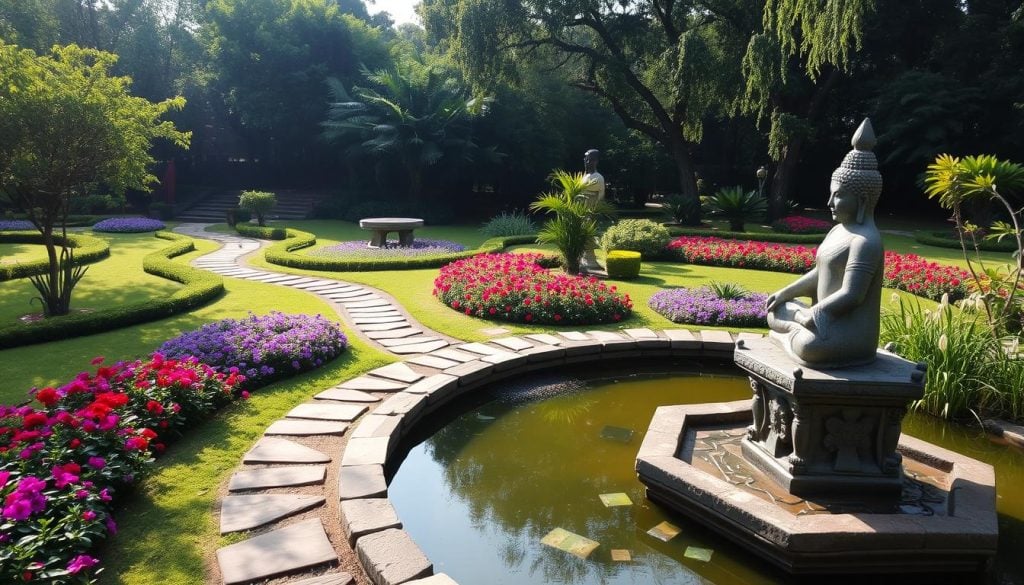
| Site | Symbolism | Activities |
|---|---|---|
| World Peace Pagoda | Global Peace | Group Meditation, Reflection |
| Eternal Peace Flame | Enduring Peace | Contemplation, Quiet Reflection |
At the World Peace Pagoda, you can meditate with others. Or, at the Eternal Peace Flame, you can reflect alone. Both places add to your Lumbini experience, inviting you to enjoy the peaceful gardens around them.
Engaging with the Local Community and Culture
The local community around Lumbini is lively and rich in culture. Joining in local festivals lets you see the spiritual heart of the people. These events show traditions that have been kept alive for years, and they welcome you to meet the friendly locals.
Participating in Local Festivals
Local festivals in Lumbini are a key to understanding the area’s customs. You’ll see colorful processions and lively dances. Taking part in these events makes your visit to the meditation gardens in Lumbini special, letting you join in the joy of community.
The Role of Volunteering in Spiritual Growth
Volunteering in Lumbini adds depth to your trip. Many groups offer chances to help out. Helping others grows your spirit and supports the area’s values of kindness. Volunteering connects you with the community and helps you find inner peace.
| Festival | Date | Activities | Significance |
|---|---|---|---|
| Buddha Jayanti | Full Moon in April | Processions, Prayer Meetings | Celebration of Buddha’s Birth |
| Lumbini Day | April 28 | Cultural Programs, Exhibitions | Commemoration of Lumbini’s Importance |
| Tihar (Deepawali) | October/November | Lighting Decorations, Singing | Festival of Lights, Celebrating Harmony |
| Dashain | September/October | Family Gatherings, Rituals | Signifying Victory of Good over Evil |
The Importance of Meditation in Lumbini
Meditation is key in Lumbini’s spiritual world. The calm setting and deep history make it perfect for quiet thought. Many meditation spots offer tools for all levels of practice.
Meditation Centers and Their Offerings
In Lumbini, you’ll find many meditation centers. They meet different needs and tastes. Here’s what they offer:
- Personal instruction tailored to your level of experience.
- Group retreats to foster a sense of community and shared learning.
- Workshops focused on mindfulness, breathing techniques, and relaxation strategies.
- Access to guided meditation sessions within tranquil settings.
Benefits of Practicing Meditation in Sacred Spaces
Meditating in sacred places like Lumbini brings special benefits. You’ll experience:
- Enhanced spiritual awareness: Dive into the spiritual vibe of Buddha’s birthplace.
- Emotional tranquility: The calm setting helps you find inner peace and emotional balance.
- Connection with nature: Meditating outside in the gardens makes the experience even deeper.
- Community engagement: Sharing meditation with others builds connection and understanding.
Visitor Experiences: What to Expect in Lumbini
Getting ready for Lumbini? You’re in for a spiritual journey. The meditation gardens are perfect for quiet thought. Nearby, sacred sites offer a chance to learn and grow.
Here are some tips to make your visit special. They’ll help you connect with Lumbini’s peaceful places.
Recommendations for Pilgrimage and Reflection
- Join guided tours to learn about each site’s history and importance.
- Find time to meditate in Lumbini’s gardens. It’s a great way to connect with nature.
- Talk to local experts. They can teach you meditation and spiritual practices.
Best Practices for a Meaningful Visit
To visit respectfully and meaningfully, follow these tips:
- Keep a calm and respectful attitude. It honors the area’s spiritual vibe.
- Take quiet moments to soak in the peace around you.
- Always ask before taking photos of sacred sites. Follow local rules.
Exploring Nearby Historical Attractions
Visiting the meditation gardens in Lumbini lets you learn more about Buddha’s life. Nearby historical sites offer a deeper look into his early years. They also show the cultural setting of this sacred area.
Kapilavastu: The Childhood Home of Buddha
Kapilavastu is a key part of Buddhist history. It was where Siddhartha Gautama, the Buddha, grew up. Walking through its ancient ruins, you feel the place where his journey began.
Devadaha: Ancestor of the Historical Sites
Devadaha is where Queen Maya Devi, the Buddha’s mother, was born. This site adds to the pilgrimage’s richness. Visiting Devadaha connects you to the Buddha’s family, offering a deeper understanding of his teachings.
The Environmental Beauty Surrounding Meditation Gardens
Visiting the tranquil gardens Lumbini shows a perfect mix of nature and spirituality. This setting greatly improves your peace-seeking journey. The wide variety of plants and animals adds to the calm atmosphere of Lumbini’s peaceful places.
Flora and Fauna of the Sacred Gardens
The gardens’ greenery and colorful flowers make a perfect setting for meditation. Many types of plants grow here, offering shade and peace. Key features include:
- Bamboo groves, known for their flexibility and strength, offering a soothing rustle in the wind.
- Lotuses, symbolizing purity, dot the water bodies and enhance the aesthetic appeal.
- Bird species, such as kingfishers and orioles, create a symphony of sounds that enrich your meditative experience.
Impact of Natural Spaces on Spiritual Wellbeing
Studies show that nature has a positive impact on our mental and spiritual health. Being in nature can lower stress, help us relax, and improve mindfulness. In Lumbini’s tranquil gardens, visitors often feel a stronger connection to themselves. The peaceful setting encourages deep thought and spiritual growth, making these gardens essential to Lumbini’s meditation experience.
Conclusion
Visiting the meditation gardens in Lumbini is more than seeing a historical site. It’s a chance to find peace, think deeply, and learn about Buddha’s spiritual legacy. These gardens are a quiet place where you can think, meditate, and connect with nature. They help you find calm in the midst of travel.
Walking through Lumbini’s sacred sites, you’ll hear many stories. The mix of history, culture, and spirituality in Lumbini enriches your experience. It touches your soul and deepens your understanding of Buddha’s teachings.
Exploring the meditation gardens in Lumbini, whether alone or with others, is rewarding. You’ll learn more about mindfulness and finding peace. Let Lumbini’s beauty change your view and guide you forward.

































